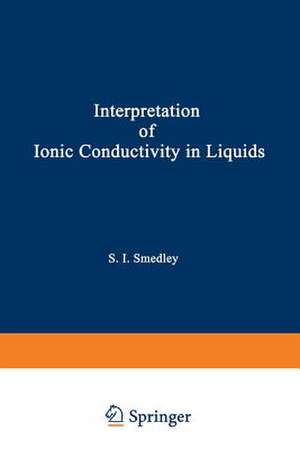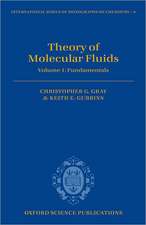The Interpretation of Ionic Conductivity in Liquids
Autor Stuart I. Smedleyen Limba Engleză Paperback – 8 mar 2012
Preț: 383.33 lei
Nou
Puncte Express: 575
Preț estimativ în valută:
73.37€ • 79.73$ • 61.67£
73.37€ • 79.73$ • 61.67£
Carte tipărită la comandă
Livrare economică 21 aprilie-05 mai
Preluare comenzi: 021 569.72.76
Specificații
ISBN-13: 9781468438208
ISBN-10: 1468438204
Pagini: 212
Ilustrații: XVI, 196 p.
Dimensiuni: 155 x 235 x 11 mm
Greutate: 0.3 kg
Ediția:Softcover reprint of the original 1st ed. 1980
Editura: Springer Us
Colecția Springer
Locul publicării:New York, NY, United States
ISBN-10: 1468438204
Pagini: 212
Ilustrații: XVI, 196 p.
Dimensiuni: 155 x 235 x 11 mm
Greutate: 0.3 kg
Ediția:Softcover reprint of the original 1st ed. 1980
Editura: Springer Us
Colecția Springer
Locul publicării:New York, NY, United States
Public țintă
ResearchCuprins
1. Introduction and Definitions.- 1.1. Introduction.- 1.2. Electrical Conductivity.- 1.3. Diffusion and Viscosity.- 1.4. The Stokes-Einstein and Nernst-Einstein Relations.- 2. Ionic Conductivity in Dilute Electrolyte Solutions.- 2.1. Concentration Dependence of Conductivity of Dilute Electrolyte Solutions—Introduction.- 2.2. The Concentration Dependence of Conductivity at High Pressure and Moderate Temperatures.- 2.3. The Concentration Dependence of Conductivity at High Pressure and Temperature.- 2.4. The Effect of Pressure on Electrical Conductivity at Ambient Temperatures.- 2.5. The Effect of Pressure on the Conductivity of Electrolyte Solutions at High Temperatures and Pressures.- 2.6. Excess H+ and OH- Mobility in Aqueous Solutions.- 2.7. The Limiting Ionic Conductivity of Ions in Solution.- 3. Ionic Conductivity in Low-Temperature Molten Salts and Concentrated Solutions.- 3.1. The Transition from Dilute Solutions to Molten Salts.- 3.2. Composition Dependence of Conductance in Concentrated Solutions and Low-Temperature Molten Salts.- 3.3. Temperature and Pressure Dependence of Conductance in Concentrated Solutions and Low-Temperature Molten Salts.- 3.4. Electrical Relaxation in Glass-Forming Molten Salts.- 4. Electrical Conductivity in Ionic Liquids at High Temperatures.- 4.1. The Temperature and Pressure Dependence of Electrical Conductivity in Ionic Liquids.- 4.2. Theories for Electrical Conductivity in Ionic Melts.- 5. Ionic Conductivity in Molecular Liquids and Partially Ionized Molten Salts.- 5.1. Introduction.- 5.2. The Temperature and Pressure Dependence of Conductivity.- 5.3. Conclusions.- 6. Electrical Conductivity in Liquids of Geological and Industrial Interest.- 6.1. Geological Liquids.- 6.2. Industrial Electrolytes.- References.










